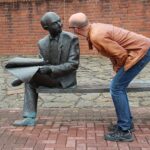We are submitting a grant proposal to the MacArthur Foundation’s Digital Media and Learning Competition.
In the spirit of transparency and collaboration, we’ll be posting our entry process, final submission and references up on this blog.
Grants are new to us as entrepreneurs, so it’s another exciting stretch for us.
We’ve received valuable advice and assistance from many, including Dave Leenhouts, Fred Stutzman, Stephanie Birdsall (of Campus Compact), Greg Hieberger, Eric Lambert (of APCA) among many others. Thank you, thank you. If we get anywhere it was because of your help.
One interesting/challenging part of the grant application is the limit on the number of words. The main proposal/ outline can only be 1000 words.
Here’s what needs to fit:
* Your project, its significance and the contribution it will make to the field of Digital Media and Learning, whom and what it will impact, the current and historical context it derives from, its further potential
* Goals for the project in the 12 month grant-term, goals beyond the grant term
* Project personnel qualifications relevant to the proposed project
* Detailed work and management plan and timeline
Here was the first draft of bullet point one, weighing in at 821 words:
Red Rover is a web application that increases student engagement and success by increasing the number of positive interpersonal connections in a campus community. These new connections create new experiential learning opportunities, mentorships, and learning communities.
Significance:
The project is significant because it breaks new ground in a number of ways.
Red Rover is the first application:
* Working within Facebook for institutions, thereby providing a communication/interface bridge between the institution and the students’ dominant social network.
* Designed from the ground up to measurably increase engagement and involvement on campus.
* Providing both institutions and student leaders with real-time “dashboard” assessment benchmarking on publicly displayed student data.
* Connecting the institution network with a blend of taxonomy and folksonomy information interfaces, allowing for both school guidance and efficient student self-organization.
* Empowering student leaders by providing simple access to best practices and mentors at other campuses related to their student organization.
* Enabling the institution and students to easily communicate through a variety of digital channels: email, social network, or text message.
* Allowing faculty to create instant ad-hoc groups around any interest using mobile technology.
Contribution:
Through an ongoing collaboration with researchers, a frequently updated blog, and tens of thousands of public clickstreams, the Red Rover project will contribute to the field of Digital Media and Learning by addressing vital questions such as:
* Can institutions use social networking to increase real-world social capital?
* Does the social safety of social networking increase opt-in rates to real-world opportunities? At what rate do online opt-ins convert to action?
* Will students embrace institutions within their online social context?
* Will students effectively use a folksonomy to navigate their connection options?
* Does a social network embedded orientation increase the effectiveness of in-person orientation?
* What are some best practices for faculty engagement with students on social networks?
Impact:
The impact of the Red Rover project is potentially enormous. By inserting an involvement increasing interface into the dominant social networks, institutional involvement itself has a chance to become viral. This will greatly impact students at every kind of institution, from private four year institutions to the smallest community colleges. Research suggests that increasing involvement will increase student G.P.A., retention rates, and satisfaction rates.
Red Rover provides all higher education institutions with a simple, free, and open source method to participate in, and benefit from, the massive change that social networking has brought to the current generation of students. Through its application and business model design, the Red Rover application can quickly and massively scale to reach every institution in the country. Through a very small, non-technical investment of time, any person at any school can set up the Red Rover platform for their institution.
Historical Context:
Red Rover derives its historical context primarily from Astin, A..W. (1985) and his research suggesting a relationship between engagement and achievement. This idea has been revisited by Upcraft (1995) who states that it is both “quantity and quality of involvement” that will lead to success. This formula suggests increasing involvement by increasing the ease and efficiency of becoming involved will increase student success. Red Rover facilitates and increases involvement both systematically, through simple interfaces embedded in Facebook, and emotionally, by utilizing the feelings of social safety and well-being created by Facebook (Ellison, et. al. 2007).
References:
Astin, A..W. (1985). Achieving educational excellence: A critical assessment of priorities and practice in higher education. San Francisco : Jossey-Bass.
Upcraft, M. Lee. (1995). Insights From Theory: Understanding First-Year Student Development. First-Year Academic Advising: Patterns in the Present, Pathways to the Future, (15-24). (Monograph # 18). Columbia, SC : University of South Carolina, The National Resource Center for The First-Year Experience and Students in Transition.
Ellison, N. B., Steinfield, C., & Lampe, C. (2007). The benefits of Facebook “friends:” Social capital and college students use of online social network sites. Journal of Computer-Mediated Communication, 12(4), article 1.
Further Potential:
Red Rover surfaces the different identity facets of students through tagging and thereby provides a fertile platform for future innovation. By attaching student data streams, using RSS feeds placed on a student’s timeline, Red Rover will be able to automatically adjust identity facets as the student progresses. Red Rover can easily expand its current group and connection recommendation engine to include identity relevant education opportunities such as actual schools, classes, internships, learning groups, mentors, mentoring opportunities, and community service. The student’s experience timeline would serve as the core of their education digital identity, providing students with a transferable digital portfolio of their growth experiences. This system design would equally apply to high schools students, many of whom are already on Facebook.
Numerous new models of, and interfaces for, self growth will inevitably surface from this new ability to connect and aggregate both experiences and reflective learning. A student’s timeline will serve as education “footprints”, and, if they choose, the student can allow these footprints to be available to other students so that they may learn from the shared experiences.




